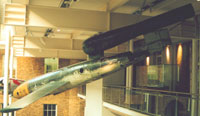|
 |
 |
 |
 |
 |
 |
 |
 |
 |
|
DIFFERENT TYPES OF BOMBS
|
|
 |
 |
|
|
|
|
|
|
 |
VI flying bomb
|
|
 |
|
|
Designed by the Fiesler Company, the V1 was an unmanned and unguided flying bomb. Powered by a pulse jet engine it could carry a 2000lb. warhead to England. It was principally a 'terror' weapon and on January 3rd., 1945, a V1 fell near the boundary of Cranfield aerodrome. It landed some 800 yards from the officers mess and the resulting explosion brought down a number of large trees. In an attempt to downplay the effect of the V1s, the propaganda radio station at nearby Milton Bryan, 'Soldatensender Calais', emphasised their inaccuracy and the fact that |
|
|
 |
 |
|
|
 |
their manufacture wasted precious raw materials, that could be better employed elsewhere. Despite the grim destruction that these weapons wrought, the propagandists housed at The Rookery, Aspley Guise, still retained a sense of humour. To escape the V1s and thereby work undisturbed, when a visiting American came to stay, in the early morning one of the team sneaked into the garden and catapaulted a lump of earth through his bedroom window. When he came down for breakfast, he then found them all excitedly talking about the 'V1" that supposedly had landed nearby during the night!
|
|
|
 |
|
The aerodrome at Cranfield attracted a great deal of attention from the Luftwaffe and on consecutive nights in August, 1940, 52 bombs and several incendaries fell on the region. Then, on September 24th., a parachute mine exploded in a field near to Cranfield and damaged several houses and shops in the High Street as well as shattering the East window of the church. Probably from the same attack another mine, complete with parachute, was found 3 weeks later hanging from a tree in |
|
|
 |
 |
|
|
 |
Hulcote Wood. Bomb disposal experts then detonated this device the following day. Mines were also dropped around the village of Aspley Guise and blew in the roof of No. 15, Bedford Road. This was then tarpaulined over for the rest of the war. Housing the canteen, the fragile 'Young Peoples Hall' was also shaken so much that 'we thought it would fall down about our ears'.
Bouncing bomb
|
|
|
 |
|
|
|
The bomb was 60 inches long and 50 inches in diameter. It had 3 hydrostatic pistols which were set to detonate at a depth of 30 feet
in the water. It had a 90 second fuse which ignited at the moment of release. It was 9250 lbs. in weight of which 6000lbs. was explosive. It was designed to make 12 bounces across the water. |
|
|
 |
 |
|
|
|
 |
Guy Gibson |
|
 |
|
|
|
On the night of 16th./17th. May, 1943, Guy Gibson led 617 Squadron on the famous Dambuster raid with 19 Lancasters. They used a 'Bouncing Bombs' in the raid. Guy Gibson had been posted to Cranfield at the end of 1941, with 29 Squadron. He flew to Cranfield to make arrangements for his position as Chief Flying Instructor. At Cranfield a lot of training was done with elderly Blenheim 1s and 1Vs. There were also some Oxfords and Lysanders. He was then posted from Cranfield to 106 Squadron in Manchester. |
|
|
 |
 |
|
|
|
 |
|
|
Back to top |
|




